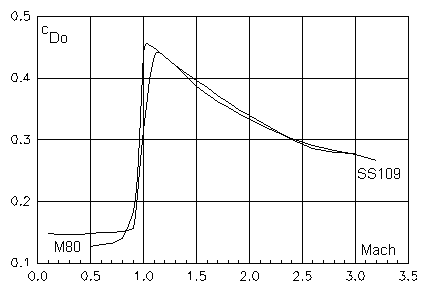The drag coefficient
The drag coefficient cD is the most important aerodynamic coefficient and generally depends on
- bullet geometry (symbolic variable B),- Mach number Ma,
- Reynolds number Re,
- the angle of yaw d
The following assumptions and simplifications are usually made in ballistics:
1. Re neglection
It can be shown, that with the exception of very low velocities, the Re dependency of cD can be neglected.2. d dependency
Depending on the physical ballistic model applied, an angle of yaw is either completely neglected (d=0) or only small angles of yaw are considered. Large angles of yaw are an indication of instability.For small angles of yaw the following approximation is usually made:
a) cD(B,Ma,d) = cDo(B,Ma) + cDd(B,Ma) * d2/2
Another theory which accounts for arbitrary angles of yaw is called the "crossflow analogy prediction method". A discussion of this method is far beyond the scope of this article, however the general type of equation for the drag coefficient is as follows:
b) cD(B,Ma,d) = cDo(B,Ma) + F(B,Ma,Re,d)
3. Determination of the zero-yaw drag coefficient

Fig.: Zero-yaw drag coefficient for two military bullets
M80 (cal. 7.62 x 51 Nato)
SS109 (cal. 5.56 x 45)
There is also software available which estimates the zero-yaw drag coefficient
as a function of the Mach number from bullet geometry. The latter method
is mainly applied in the development phase of a new projectile.
4. Standard drag functions
Generally each bullet geometry has its own zero-yaw drag coefficient as a function of the Mach number. This means, that specific - time-consuming and expensive - measurements would be required for each bullet geometry. A widely used simplification makes use of a "standard drag function" cDo standard which depends on the Mach number alone and a form factor iD which depends on the bullet geometry alone according to:cDo(B,Ma) = iD(B) * cDo standard(Ma)
If this simplification is applicable, the determination of the drag coefficient of a bullet as a function of the Mach number is reduced to the determination of a suitable form factor alone. It will be shown that the concept of the ballistic coefficient, widely used in the US for small arms projectiles follows this idea.
Abbreviations
|
|
Drag coefficient; cD(B,Ma,Re,d) |
|
|
Zero-yaw standard drag function |
|
|
Form factor |